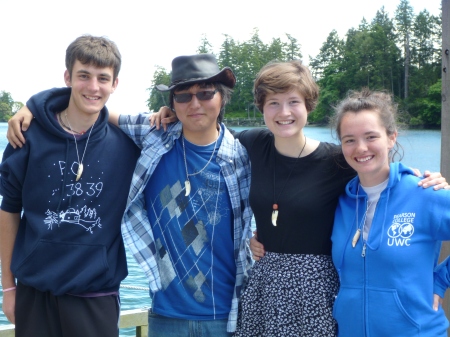Congratulations year 39 marine scientists!
P.S. Thanks to Nazim for the photos with taken with a fish-eye lens (very Marine Science-y!).
Second year Marine Science students in C block chose to investigate the effect of colour of light on primary productivity in bull kelp (Nereocystis luetkeana). After wrapping five BOD bottles in each of five colours of cellophane plus five bottles in transparent cellophane and including five black bottles, students filled BOD bottles with seawater and one piece (4 cm x 4 cm) of bull kelp.
They measured dissolved oxygen in each bottle:
then left the bottles on the window sill of the floating lab for 4 to 6 hours:
Then they measured dissolved oxygen again:
The data collected are shown below:
And I have to include this photo of the wall by the stairs in the floating lab taken when students were measuring final oxygen levels:
The first three clips were taken by snorkelling Steph (8 October 2013) and the last two videos are the raw footage from the dive that Lily and Lucas did at Fossil Point (10 October 2013).
On Tuesday 8 October and Thursday 10 October, second year marine scientists journeyed to a small kelp forest near Fossil Point.
Griffin & Ivan did a dive in the kelp on Tuesday, while Lily & Lucas (pictured below) went on Thursday.
Divers took a video camera with them that is connected via a cable to a monitor in the cabin of the boat so that students not in the water could see what the divers see, in real time.
We even saw a diver underwater: Lily in the photo below!
Several students also snorkelled to experience the kelp forest.
Some of the species observed include: bull kelp (Nereocystis luetkeana) of course!, cross jellyfish (Mitrocoma cellularia), blood star (Henricia sp.):
Sunflower star (Pycnopodia helianthoides):
Hooded nudibranch (Melibe leonina):
A brittle star in a kelp holdfast:
And ochre stars (Pisaster ochraceus):
Two wonderful trips!
Second year Marine Science students made the annual trek to the mudflats located just across from the College in Pedder Bay this morning and yesterday morning at 6:45 am. I am somewhat disappointed to report that not a single student got stuck this year.
Taran was almost stuck, but managed to free herself too easily – no need for rescuing!
Sophia got a little bit of mud on her special suit…
…but it rinsed off easily.
Group photos of each class are below – see how happy everyone is?!

Ivan (far left) and Steph (far right), both year 39, each received a sea lion canine tooth from Chris and Sammy (year 38) on the PC dock this afternoon to recognize their outstanding enthusiasm for Marine Science.
It was a sunny but windy afternoon yesterday in the intertidal zone with D block. We saw a few things of note…
At least Ehsan & Ivan were taking note!
A dead California sea cucumber (Parastichopus californicus). Very curious about the circumstances surrounding its arrival in the intertidal zone.
And we saw lots of eggs – several yellow whelk egg capsules and green fish eggs wedged into a crack in the rock.
We also collected some hairy hermit crabs for Tom’s extended essay work on shell selection in hermit crabs.
First year marine scientists travelled to East Sooke Park during block week (D block on 5 March and B block on 6 March) where they explored the intertidal zone. We saw many amazing creatures and seaweeds, including:
Spawning Nucella lamellosa with an interloping N. canaliculata on the far right.
More spawning Nucella lamellosa
Lacuna egg masses
The dwarf mottled blood star, Henricia pumila & eggs (the bright orange goo to the right of the black leather chiton, Katharina tunicata). I have not seen these eggs before and was very interested to learn that this species has only recently been described (2010) and it broods its eggs, unlike other Henricia species which are broadcast spawners.
Amit with another species of Henricia.
This nemertean Cerebratulus californiensis was crawling on the sandy beach when Alba spotted it. Alba certainly has an eye for worms – she also spotted the nereid worm pictured below.
The worm (Nereis vexillosa) did show off its big black jaws (but not in this photo unfortunately).
Lucas found this striped sun star, Solaster stimpsoni, which did have a commensal worm…
Solaster stimpsoni and its commensal scale worm, Arctonoe vittata (seen to the right of sea star’s mouth).
Kiera found a pair of six armed stars (Leptasterias hexactis).
And Griffin found a sea leopard, Dialula sandiegensis.
The sea leopard, Dialula sandiegensis.
The brooding anemone, Epiactis prolifera, one with no offspring and the other (on the right) with many offspring!
A well camouflaged decorator crab…
…not so well camouflaged on Marc’s hand.
Mastocarpus sp. and Ulva lactuca.
Periwinkles (Littorina sitkana) in the crack of a boulder
Students had a wonderful time on Wednesday, despite the wet weather!
It only drizzled on Tuesday, but Steph still managed to get quite wet – she filled her boots!
Here is a fairly complete species list from the two days at East Sooke Park:
Haliclona sp., Halichondria panicea, Ophlitospongia pennata
Anthopleura elegantissima, Urticina crassicornis, and other Urticina spp.
Cerbratulus californienesis
Eudistylia vancouveri, Nereis vexillosa
Mopalia muscosa, Katharina tunicata, Mytilus californiensis, Diadora aspera (with commensal worm), Littorina sitkana, Nucella ostrina, Nucella lamellosa, Nucella canaliculata, Archidoris montereyensis, Dialula sandiegensis (and egg mass)
Pollicipes polymerus, Balanus glandula, Semibalanus cariosus, Chthamalus dalli, Idotea wosnesenskii, Hemigrapsus nudus, Hemigrapsus oregonensis, Petrolisthes sp., Decorator crab, Pagurus hirsutiusculus, Pugettia producta, Cancer productus (juvenile), Cancer oregonensis
Pycnopodia helianthoides, Pisaster ochraceus, Evasterias troschelii, Henricia pumila (with eggs), and other Henricia spp., Lepasterias hexactis
Oligocottus maculosus, Gobiesox meandricus, Gunnels (one guarding eggs)
Ulva lactuca, Enteromorpha intestinalis, Acrosiphonia coalita, Codium fragile
Hedophyllum sessile, Fucus gardeneri, Nereocystis luetkeana, Macrocystis integrifolia (drift)
Mazaella sp., Corallina vancouverensis, Bossiella sp., Lithothamnion sp., Odonthalia floccosa, Endocladia muricata, Prionitis lanceolata